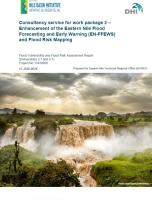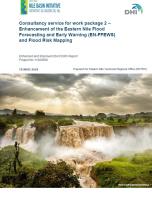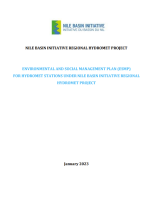Abstract
The Nile Basin accounts for an enormous physical area, a substantial population and has an exceptionally rich
natural resource base – as well as containing some of the poorest human communities and most fragile
ecosystems on earth. Natural, social and economic processes across the eleven riparian countries of Burundi,
Democratic Republic of Congo, Egypt, Eritrea, Ethiopia, Kenya, Rwanda, South Sudan, Sudan, Tanzania and
Uganda (Figure 1) are variously enabled or hindered by water resource availability and access. In the face of a
rapidly growing population, progressive urbanisation and industrialisation, increasing market integration and
steeply rising needs for food, energy and raw materials, massive questions remain about how best to use and
manage the river basin and its water resources.
Natural ecosystems, particularly wetlands, play a central role in the functioning of this massive water economy
(and the people and industries that are involved in it). From an economic perspective, they form a key part of
‘natural’ water infrastructure in the Nile Basin – the stock of equipment, facilities and services that is required for
the region’s societies and economies to survive, grow and prosper (Emerton and Bos 2004). Wetland ecosystem
services, “the benefits people obtain from ecosystems” (Millennium Ecosystem Assessment 2005a), range from
water storage, flow and quality regulation, through watershed protection, drought mitigation, flood control and
disaster risk reduction, to the generation of a wide range of goods and services, products and raw materials that
underpin local livelihoods, large-scale industrial production and even international trade flows.
Yet, paradoxically, both economists and water planners have long been perceived natural ecosystems as having
little value. Calculations of the returns to different land, resource and investment options in river basins have for
the most part failed to take account of ecosystem costs and benefits. It is therefore perhaps hardly surprising
that, across the Nile Basin, wetlands and other natural ecosystems have long been modified, converted, overexploited and degraded in the interests of other more ‘productive’ alternatives which appear to yield much higher
and more immediate profits. Experience shows that such omissions have however often proved extremely costly,
because they result in huge losses, damages and missed opportunities due to the loss of these vital ecosystem,
services – for water investors and river basin managers, as well as for the industries and households that depend
on clean and regular water supplies. For the most part, the calculations that underpin water management and
river basin development decisions therefore remain fundamentally incomplete – and potentially misleading in
their conclusions and recommendations to decision-makers.




